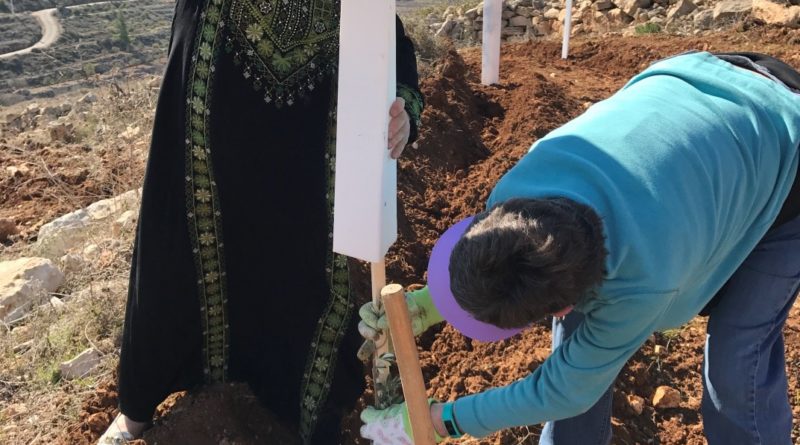Keep Hope Alive by Barbara Sheets
In February 2017, Rev. Dr. Jeff DeYoe, pastor of Covenant Presbyterian Church in Fort Myers, Florida, led a group on a Keep Hope Alive (KHA) trip to Israel/Palestine. The KHA trips are part of the East Jerusalem YMCA/YMVCA Joint Advocacy Initiative providing an international presence as solidarity and witness for the Palestinian olive harvest in the fall, and for olive tree planting in winter. This was Rev. DeYoe’s 5th trip to the region. The articles appearing this week are reports from the ground by “people in the pews” who went with him and stood as witness. Each traveler approached the trip from a different place in their faith and life journey. Through these posts edited by Noushin Framke, Ecclesio is pleased to take you to the olive groves in Palestine through their varied lenses.
Keep Hope Alive. This is the mantra of the Olive Tree Campaign, an initiative between the East Jerusalem YMCA and the YWCA of Palestine called the Joint Advocacy Initiative (JAI). It was this focus that took me to Palestine and Olive tree planting. Our trip was in February and it was the second planting trip for our church, Covenant Presbyterian in Fort Myers, Florida, led by our pastor, Rev. Dr. Jeff DeYoe, who is also the moderator of the Israel Palestine Mission Network of the Presbyterian Church (USA). [theIPMN.org]
The olive tree is culturally, socially, historically, politically and economically significant. These trees are holy to Palestinians, mentioned in several verses in the Bible and the Quran. The oldest and largest olive tree in Palestine grows in Al-Walaja, a small village west of Bethlehem, and is believed to be over 4,500 years old. For Palestinians, the olive tree represents their struggle to stay in their land despite continuous harassment and attacks. The olive branch is often used as a symbol of peace.
Palestinians are largely farmers. Before 1948 and their displacement when Israel was created, 75% of these farmers made their living in agriculture. Much of the landscape is made up of olive fields which can be traced back over six thousand years. Today, around 14% of the population in Palestine is involved in farming. Forty-five percent of Palestinian agricultural land is planted with around 11 million olive trees, making up around 67% of the total trees in Palestine.
Since 1948, Palestinians have continued to lose their land and natural resources, including water. The first thing that was pointed out to me when I arrived in Palestine was the black water tanks on the roof of the houses. Water is pumped from aquifers in Palestine to Israel, and then pumped back and sold to the Palestinians. At will, the Israelis can turn it off, leaving the Palestinians without water. So they store it on the roof for use when needed. Since Israelis don’t get their water shut off, they generally don’t have water tanks on their roofs.
Palestinians are restricted in many ways. In 2002, a wall began to be built. In some areas, it is an 8 meter (26 ft) high concrete mass with armed snipers every 300m (984ft); in other parts it is an 80-150m (261-492 ft) swath of razor wire, sand, electric fencing, dirt and military roads. By 2012 approximately 440 km (136 mi) of a projected 708 km (258 mi) was finished, while 212km (131 mi) was under construction. This wall does not follow legal boundaries. Ninety percent is inside Palestinian land. Since the wall is not built on the border, Israelis take Palestinian land, seizing olive tree fields, homes and other agricultural fields. Palestinians are cut off from water supplies, their fields, and other Palestinian villages and communities. The farmers have to get permits to get to their own fields and often-times have to travel a long distance to get to the field that is just on the other side of the wall.
Palestinians are allowed to leave only on set days and times. There is no hospital in the West Bank. A permit has to be applied for to leave Palestine to go to a hospital in Israel. We waited in traffic for 45 minutes to go through a check point on a tour bus, and when we got there we were made to turn around because the bus driver did not have the right permit. We were touring in Hebron, a Palestinian city where the main market street was blocked off by Israelis soldiers. Our tour group would be allowed to go through, however, our guide would not because he was Palestinian. These are just a few of the outrageous restrictions we saw placed on these amazingly resilient people.
The preceding information is to give you an idea of the importance of the Olive Tree Campaign in Palestine. During our visit, we planted on four days. February 6, we planted in the field of Husny Salah in the al Khader village. The field is approximately 4.2 acres and is surrounded by 3 Israeli settlements (Navi Daniel, Ele Azai and Efrat). We planted 400 olive tree saplings. Shortly before we finished, Israeli soldiers arrived to challenge the planting but we were able to finish. Fatima Salah, the owner’s wife, told us, “we are pleased and grateful for your presence and help in saving our land.” The farmer provided coffee as we planted, and lunch when we finished.
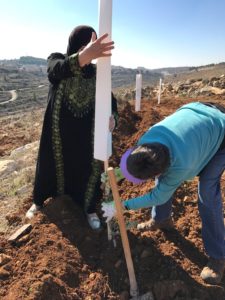 February 8 we had a long walk uphill to the field of Issa Salah, also in the al Khader village. This field was very close to an Israeli outpost (the beginnings of a settlement) called Sedi Boaz. This field was approximately 5 acres and our plan was to plant 400 trees. However, the Israeli soldiers arrived and after a time of checking and waiting, they stopped our planting; we had only planted 300 trees. The farmer served us a wonderful lunch of stuffed grape leaves in the field. We were informed, sadly, the next day, that all of the trees were uprooted and destroyed by settlers during the night. We were assured that they would plant again and again until the trees are left alone. It has been done before as many as four times.
February 8 we had a long walk uphill to the field of Issa Salah, also in the al Khader village. This field was very close to an Israeli outpost (the beginnings of a settlement) called Sedi Boaz. This field was approximately 5 acres and our plan was to plant 400 trees. However, the Israeli soldiers arrived and after a time of checking and waiting, they stopped our planting; we had only planted 300 trees. The farmer served us a wonderful lunch of stuffed grape leaves in the field. We were informed, sadly, the next day, that all of the trees were uprooted and destroyed by settlers during the night. We were assured that they would plant again and again until the trees are left alone. It has been done before as many as four times.
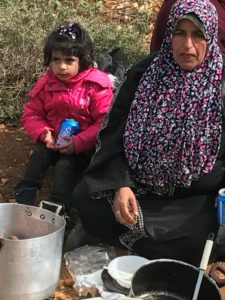 Our third day, February 10, was in a beautiful field surrounded on two sides by awesome terraced fields that probably looked like that for thousands of years. On the other sides was the very large settlement of Efrat. On 3.5 acres, owned by Isaa Sakeba, we planted 350 trees that day. The Israeli soldiers paid us a visit again but this day, we were allowed to finish our planting. We had lunch in the field with fresh citrus fruit for dessert.
Our third day, February 10, was in a beautiful field surrounded on two sides by awesome terraced fields that probably looked like that for thousands of years. On the other sides was the very large settlement of Efrat. On 3.5 acres, owned by Isaa Sakeba, we planted 350 trees that day. The Israeli soldiers paid us a visit again but this day, we were allowed to finish our planting. We had lunch in the field with fresh citrus fruit for dessert.
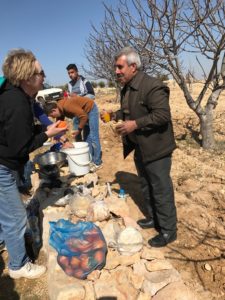 The final day of planting was February 12, Sunday morning. As we walked in, we passed a road surrounded by electric fence and razor wire in front of a wall and check point tower; a military area. The field was owned by four Palestinians; Mousa Abu Tous, Mohamad Al Tous, Mahmoud Al Tous and Ibrahem Abu Lalefah. The field was approximately 6 acres and we planted 430 trees. Sheep grazed calmly in the near area and it was quiet and beautiful. As was the routine in prior fields, we had lunch in the area just before the skies opened up with very cold rain. No military presence on this day.
The final day of planting was February 12, Sunday morning. As we walked in, we passed a road surrounded by electric fence and razor wire in front of a wall and check point tower; a military area. The field was owned by four Palestinians; Mousa Abu Tous, Mohamad Al Tous, Mahmoud Al Tous and Ibrahem Abu Lalefah. The field was approximately 6 acres and we planted 430 trees. Sheep grazed calmly in the near area and it was quiet and beautiful. As was the routine in prior fields, we had lunch in the area just before the skies opened up with very cold rain. No military presence on this day.
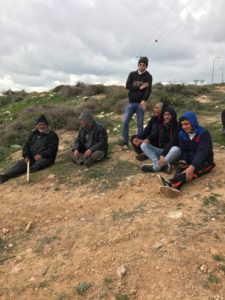 The planting was hard work. It was cold. But our hearts were warmed by the comradery of those planting with us; those who organized the planting, and most of all by the Palestinian people. As Fatima Salah said on the first day, the hope of these farmers and the Palestinian people as a whole, lies in keeping their ancestral lands. Planting Olive trees holds that land, and in turn, keeps hope alive!
The planting was hard work. It was cold. But our hearts were warmed by the comradery of those planting with us; those who organized the planting, and most of all by the Palestinian people. As Fatima Salah said on the first day, the hope of these farmers and the Palestinian people as a whole, lies in keeping their ancestral lands. Planting Olive trees holds that land, and in turn, keeps hope alive!
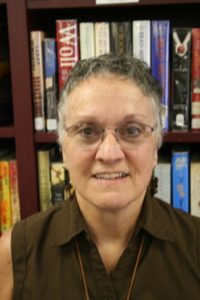 Barbara Sheets is a retired accounting office manager. She is mother of three, grandmother of eight. She has been active at Covenant Presbyterian Church in Fort Myers, Florida for 22 years. This was her first trip to Palestine.
Barbara Sheets is a retired accounting office manager. She is mother of three, grandmother of eight. She has been active at Covenant Presbyterian Church in Fort Myers, Florida for 22 years. This was her first trip to Palestine.

